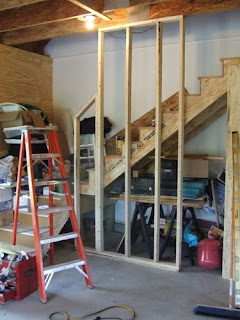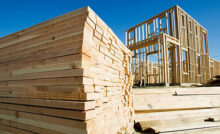

Framing a raked wall doesn’t have to be that complicated as long as you plan things out and take your time. Raked walls are very common with cathedral ceilings and along staircases. For me the best way to approach building a raked wall is to make a quick sketch of the wall in order to visualize it and help reduce mistakes.
For my walls I’ve got several different scenarios. I’ve got a short raked wall from the first step up to the landing. Then I wanted to have a short piece of raked wall for the first 16 inches so I can make the corner easier with long materials. Then the wall will be full height for about 4 feet. Then the wall transitions to a reverse raked wall (the wall goes all the way up to the ceiling and the raked portion follows the slope of the stair stringer.


The math is: 7.625 / 10 = Y / 16 Therefore Y = 7.625 x 16 / 10 = 12.2
So, all you have to do is set up your saw for the angle of the slope = Inv Tan (7.625/10) = 37.3 degrees. Then cut the first stud (the shortest one) based on the starting height you need. Then you cut each consecutive stud 12.2 inches longer with the same angle on the top.
The best way to make sure you don’t make a mistake is to draw the full size version of the wall on the floor. Once you’ve drawn the wall on the floor you’ll be able to check each stud as you cut it.
As you can see in the photo at the top I broke this wall up into two sections. I built the section with the short raked portion first. I’ll post more pictures when I finish framing the raked wall tomorrow.
Recent Posts
Framing Stick Nailer vs Coil Nailer
Which is Better a Stick Nailer or Coil Nailer? Framers have many choices in nailers…
How Many Roofing Nails Per Square of Shingles
Estimating How Many Nails for a New Roof When it comes to estimating materials for…
Composite / PVC Decking – Layout Tips & Advice
Composite / PVC Decking Layout Tips and Advice Composite and PVC decking have really changed…
Benefits of an ERV System (Energy Recovery Ventilator)
Benefits of ERV Systems (Energy Recovery Ventilator) If you're building a new home or doing…
Vermiculite Attic Insulation Abatement
Vermiculite Attic Insulation If your home was built before 1990 there is a chance it…
Nuisance Tripping of AFCI (Arc Fault) Circuit Breakers
Arc Fault (AFCI) Circuit Breakers Tripping Often An arc-fault circuit interrupter (AFCI) or arc-fault detection…
